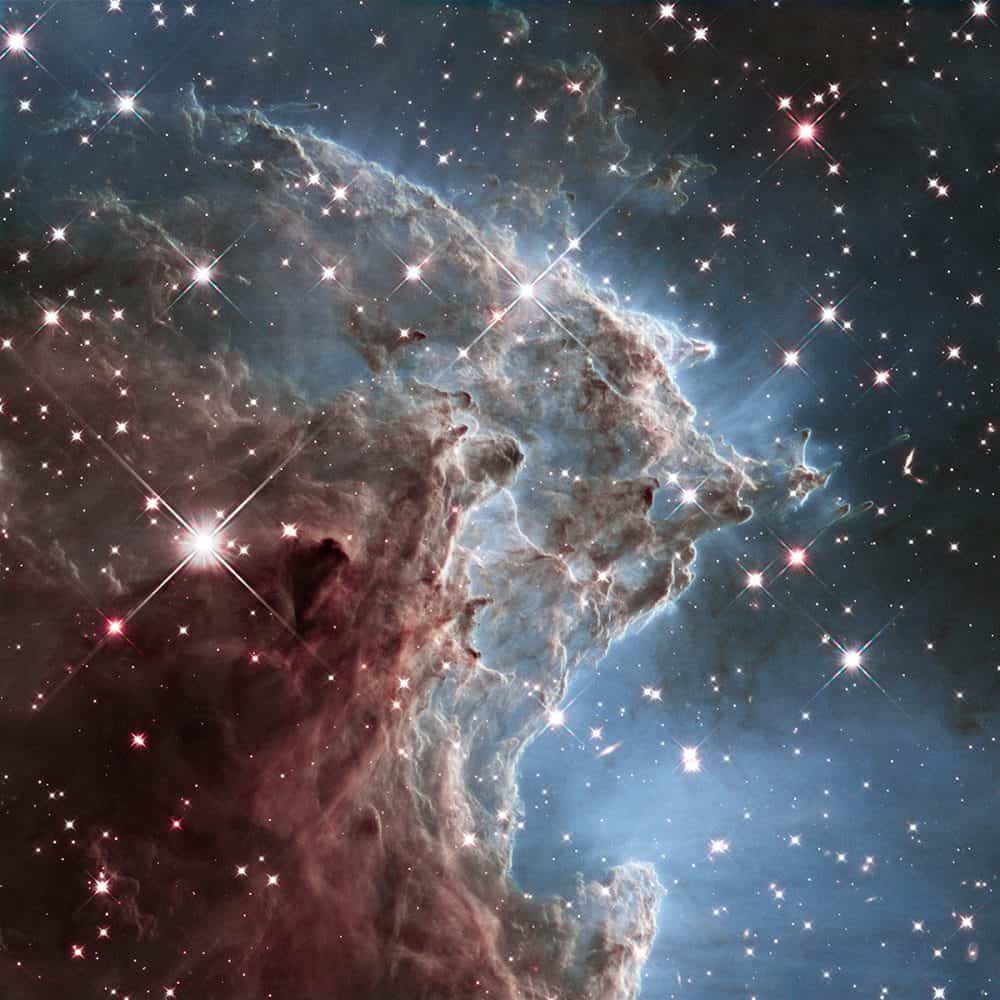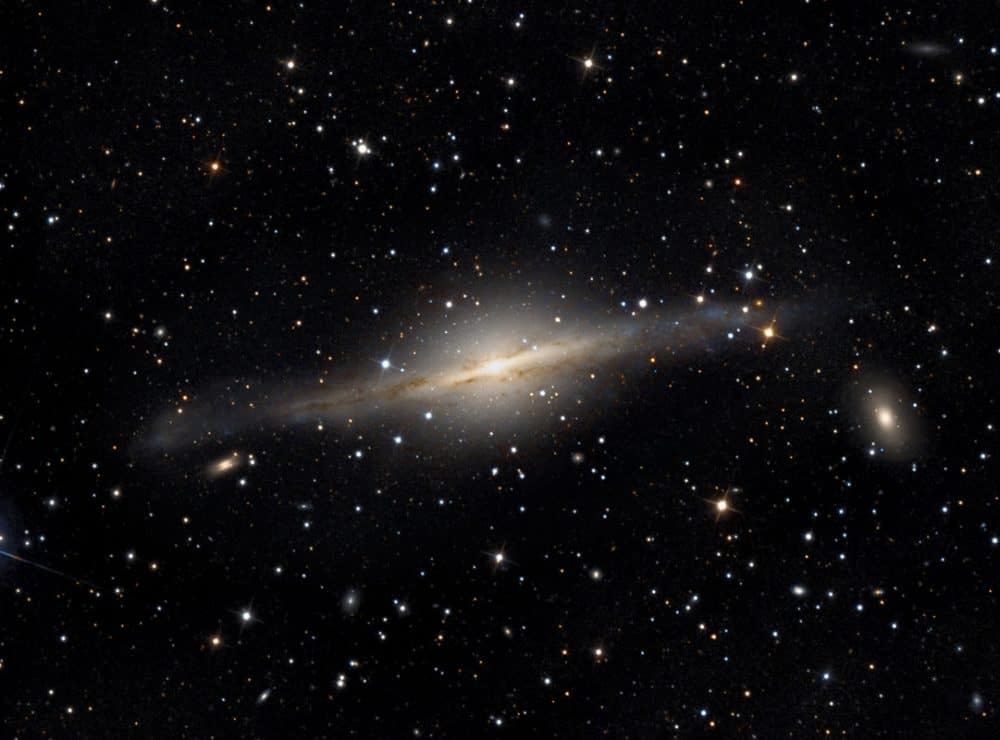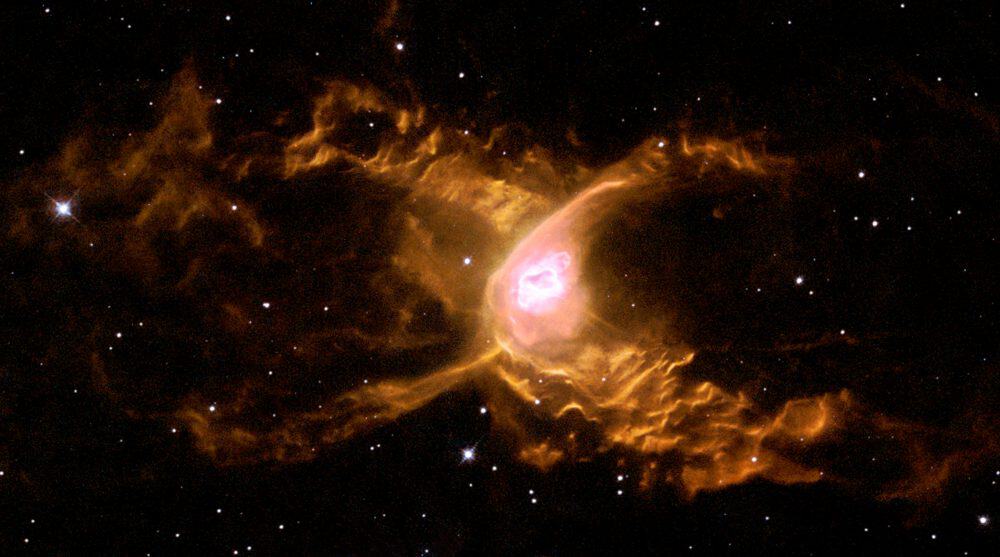Blog
n celebration of the 24th anniversary of the launch of NASA’s Hubble Space Telescope (on April 24, 1990) astronomers have taken an infrared-light portrait of a roiling region of starbirth located 6,400 light-years away.
The Hubble mosaic unveils a collection of carved knots of gas and dust in a small portion of the Monkey Head Nebula (also known as NGC 2174 and Sharpless Sh2-252). The nebula is a star-forming region that hosts dusky dust clouds silhouetted against glowing gas.
Massive, newly formed stars near the center of the nebula (and toward the right in this image) are blasting away at dust within the nebula. Ultraviolet light from these bright stars helps carve the dust into giant pillars. The nebula is mostly composed of hydrogen gas, which becomes ionized by the ultraviolet radiation.
As the interstellar dust particles are warmed from the radiation from the stars in the center of the nebula, they heat up and begin to glow at infrared wavelengths.
The image demonstrates Hubble’s powerful infrared vision and offers a tantalizing hint of what scientists can expect from the upcoming James Webb Space Telescope.
more...Maurice “Mobetta” Brown (born January 6, 1981) originally from Harvey, Illinois is a Grammy Award-winning American jazz trumpeter, producer and composer. As a member of Tedeschi Trucks Band, he shared the 2011 Grammy for Best Blues Album (Revelator).
Brown began college at Northern Illinois University, then transferred to Southern University in Baton Rouge, Louisiana, studying under jazz clarinetist Alvin Batiste. After winning first place in the National Miles Davis Trumpet Competition, he moved to New Orleans, where he led a regular Tuesday night residency at the Snug Harbor jazz club and released his first album, “Hip to Bop”.
After Hurricane Katrina, Brown relocated back to Chicago, then to New York City. He currently splits time between his residence in the Bedford-Stuyvesant neighborhood of Brooklyn and Los Angeles.
https://www.youtube.com/watch?v=ZYsK9itHC1k
more...Earl Eugene Scruggs (January 6, 1924 – March 28, 2012) was an American musician noted for popularizing a three-finger banjo picking style, now called “Scruggs style“, that is a defining characteristic of bluegrass music. His three-finger style of playing was radically different from the ways the five-string banjo had been historically played. He popularized the instrument in several genres of music and elevated the banjo from its role as a background rhythm instrument, or a comedian’s prop, into featured solo status.
Scruggs’ career began at age 21 when he was hired to play in a group called “Bill Monroe and the Blue Grass Boys”. The name “bluegrass” eventually became the eponym for the entire genre of country music now known by that title. Despite considerable success with Monroe, performing on the Grand Ole Opry and recording classic hits like “Blue Moon of Kentucky“, Scruggs resigned from the group in 1946 due to their exhausting touring schedule. Band member Lester Flatt resigned as well, and he and Scruggs later paired up in a new group called “Flatt and Scruggs and the Foggy Mountain Boys“. Scruggs’ banjo instrumental called “Foggy Mountain Breakdown“, released in 1949, became an enduring hit, and had a rebirth of popularity to a younger generation when it was featured in the 1967 film Bonnie and Clyde. The song won two Grammy Awards and, in 2005, was selected for the Library of Congress’ National Recording Registry of works of unusual merit.
Scruggs was born January 6, 1924, in Flint Hill, Cleveland County, North Carolina, a small community just outside of Boiling Springs, about 10 miles west of Shelby. His father, George Elam Scruggs, was a farmer and a bookkeeper who died of a protracted illness when Earl was four years old. Upon his death, Scruggs’ mother, Georgia Lula Rupee (called Lula), was left to take care of the farm and five children, of which Earl was the youngest.
Scruggs is noted for popularizing a three-finger banjo-picking style now called “Scruggs style” that has become a defining characteristic of bluegrass music. Prior to Scruggs, most banjo players used the frailing or clawhammer technique, which consists of holding the fingers bent like a claw and moving the entire hand in a downward motion so that the strings are struck with the back of the middle fingernail. This motion is followed by striking the thumb on a single string. The three-finger style of playing is radically different from frailing; the hand itself remains stationary and only the fingers and thumb move, somewhat similar to classical guitar technique.Scruggs style also involves using picks on three digits, each plucking three individual stings — downward with the thumb, then upward with the index and middle finger in sequence. When done skillfully and in rapid sequence, the style allows any digit (though usually the thumb) to play a melody, while the other two digits play arpeggiosof the melody line. The use of picks gives each note a louder percussive attack, creating an exciting effect, described by The New York Times as “like thumbtacks plinking rhythmically on a tin roof”.
more...Gato Preto (“Black Cat” in Portuguese) is a music project from rapper Gata Misteriosa (Mozambique/Portugal) and DJ/producer Lee Bass (Ghana/Germany).
more...NGC 2282 (pictured here). Not much research has been carried out regarding this region, but its size and distance have been determined; it lurks about 5,500 light-years from Earth, and spans approximately 5 light-years across.
Found in the constellation of Monoceros, NGC 2282 is believed to be the site of ongoing star formation activity, perhaps giving life to a few hundred stars. Many of which are somewhere between 5 and 10 million years old, basically newborns. What’s more is that at least 9% are pre main-sequence.
Based on their infrared signature, research indicates that the cluster is situated on the outskirts of a molecular cloud, which may aid in the formation of the reflection nebula this image — taken by Adam Block of the Mount Lemmon Sky Center — brilliantly displays.
more...Paul Wertico (born January 5, 1953 in Chicago, Illinois) is an American drummer. He gained recognition as a member of the Pat Metheny Group from 1983 until 2001, leaving the group to spend more time with his family and to pursue other musical interests.
He formed the Paul Wertico Trio and collaborated with Larry Coryell, Kurt Elling, and Jeff Berlin. From 2000 to 2007, he was a member of SBB, the platinum-record-winning Polish progressive rockband. Wertico was a member of the Larry Coryell Power Trio until Coryell’s death in 2017.
more...Elizabeth “Libba” Cotten (née Nevills) (January 5, 1893 – June 29, 1987) was an American blues and folk musician, singer, and songwriter. A self-taught left-handed guitarist, Cotten developed her own original style. She played a guitar strung for a right-handed player, but played it upside down, as she was left-handed. This position required her to play the bass lines with her fingers and the melody with her thumb. Her signature alternating bass style has become known as “Cotten picking”.
Cotten was born in 1893 in Chapel Hill, North Carolina, to a musical family. Her parents were George Nevill (also spelled Nevills) and Louisa (or Louise) Price Nevill. Elizabeth was the youngest of five children. At age seven, she began to play her older brother’s banjo. “From that day on,” she said, “nobody had no peace in that house.” By the age of eight, she was playing songs. At the age of 11, after scraping together some money as a domestic helper, she bought her own guitar. The guitar, a Sears and Roebuck brand instrument, cost $3.75 (equivalent to $105 in 2018). Although self-taught, she became proficient at playing the instrument. By her early teens she was writing her own songs, one of which, “Freight Train“, became one of her most recognized. She wrote the song in remembrance of a nearby train that she could hear from her childhood home. The 1956 UK recording of the song by Chas McDevitt and Nancy Whiskey was a major hit and is credited as one of the main influences on the rise of skiffle in the UK.
more...Alioune Kassé was born in Dakar, Senegal. He belongs to the Tukulor ethnic group and is a writer, composer and player.
more...It’s hard to describe the music of Indonesian group Senyawa. The duo makes experimental music that crosses various musical boundaries. Singer Rully Shabara uses various forms of vocals, ranging from shamanic throat sounds to whispered lyrics in various layers. Multi-instrumentalist Wukir Suryadi plays a wide range of musical instruments that include conventional ones as well as homemade devices.
more...NGC 5084 is a lenticular galaxy in the constellation of Virgo. It is located at a distance of circa 80 million light years from Earth, which, given its apparent dimensions, means that NGC 5084 is at least 200,000 light years across. It is one of the largest and most massive galaxies in the Virgo Supercluster. It was discovered by William Herschel on March 10, 1785. The galaxy is seen nearly edge-on, with inclination 86°, and features a warped disk and large quantities of HI gas extending along the disk, probably accumulated after multiple accretions of smaller galaxies.
more...John McLaughlin (born 4 January 1942), also known as Mahavishnu John McLaughlin, is an English guitarist, bandleader and composer. His music includes many genres of jazz which he coupled with elements of rock, Indian classical music, Western classical music, flamenco and blues to become one of the pioneering figures in fusion.
After contributing to several key British groups of the early 1960s McLaughlin made Extrapolation, his first album as a bandleader, in 1969. He then moved to the U.S., where he played with Tony Williams‘s group Lifetime and then with Miles Davis on his electric jazz-fusion albums In a Silent Way, Bitches Brew, Jack Johnson, and On the Corner.
His 1970s electric band, the Mahavishnu Orchestra, performed a technically virtuosic and complex style of music that fused electric jazz and rock with Indian influences.
McLaughlin has been cited as an influence by a number of prominent musicians. He is a Grammy Award winner and has been awarded multiple “Guitarist of the Year” and “Best Jazz Guitarist” awards from magazines such as DownBeat and Guitar Player based on reader polls. In 2003, he was ranked 49th in Rolling Stone magazine’s list of the “100 Greatest Guitarists of All Time“. In 2009, DownBeat included McLaughlin in its unranked list of “75 Great Guitarists”, in the “Modern Jazz Maestros” category. In 2012, Guitar World magazine ranked him #63 on its top 100 list. In 2010, guitarist Jeff Beck called him “the best guitarist alive”. McLaughlin was also referred to as the best guitarist alive by Pat Metheny.
https://www.youtube.com/watch?v=b9w8Py9pcpY
more...
Frank Wellington Wess (January 4, 1922 – October 30, 2013) was an American jazz saxophonist and flautist. In addition to his extensive solo work, Wess is remembered for his time in Count Basie‘s band from the early 1950s into the 1960s. Critic Scott Yannow described him as one of the premier proteges of Lester Young, and a leading jazz flautist of his era—using the latter instrument to bring new colors to Basie’s music.
Wess was considered one of the best jazz flautists of his time. From 1959 to 1964, he won the Down Beat magazine critics’ poll for flute.
He was a member of Clark Terry‘s big band from 1967 into the 1970s and played in the New York Jazz Quartet (with Roland Hanna). He also did a variety of work for TV. In 1968 he contributed to the album The Jazz Composer’s Orchestra. He played tenor and alto sax, doubling on flute throughout his career.
more...Huge waves are sculpted in this two-lobed nebula some 3000 light-years away in the constellation of Sagittarius. This warm planetary nebula harbours one of the hottest stars known and its powerful stellar winds generate waves 100 billion kilometres high. The waves are caused by supersonic shocks, formed when the local gas is compressed and heated in front of the rapidly expanding lobes. The atoms caught in the shock emit the spectacular radiation seen in this image.
more...James Carter (born January 3, 1969) is an American jazz musician. He is the cousin of jazz violinist Regina Carter.
On May 31, 1988, at the Detroit Institute of Arts (DIA), Carter was a last-minute addition for guest artist Lester Bowie, which turned into an invitation to play with his new quintet (forerunner of his New York Organ Ensemble) in New York City that following November at the now defunct Carlos 1 jazz club. This was pivotal in Carter’s career, putting him in musical contact with the world, and he moved to New York two years later. He has been prominent as a performer and recording artist on the jazz scene since the late 1980s, playing saxophones, flute, and clarinets.
On his album Chasin’ the Gypsy (2000), he recorded with his cousin Regina Carter, a jazz violinist.
Carter has won Down Beat magazine’s Critics and Readers Choice award for baritone saxophone several years in a row. He has performed, toured and played on albums with Lester Bowie, Julius Hemphill, Frank Lowe & the Saxemble, Kathleen Battle, the World Saxophone Quartet, Cyrus Chestnut, Wynton Marsalis, Dee Dee Bridgewater and the Mingus Big Band.
https://www.youtube.com/watch?v=1MFRhQs8aig
more...Herbert Horatio Nichols (3 January 1919 – 12 April 1963) was an American jazz pianist and composer who wrote the jazz standard “Lady Sings the Blues“. Obscure during his lifetime, he is now highly regarded by many musicians and critics.
He was born in San Juan Hill, Manhattan in New York City, to parents from St. Kitts and Trinidad, and grew up in Harlem. During much of his life he took work as a Dixieland musician while working on the more adventurous kind of jazz he preferred. He is best known today for these compositions, program music that combines bop, Dixieland, and music from the Caribbean with harmonies from Erik Satie and Béla Bartók.
His first known work as a musician was with the Royal Barons in 1937, but he did not find performing at Minton’s Playhouse a few years later a very happy experience. The competition didn’t suit him. However, he did become friends with pianist Thelonious Monk even if his own critical neglect would be more enduring.
more...More Posts
- Clarence Ford
- Kanaka Dasa
- Flamenco Fridays with Álvaro Pérez “Martinete”
- Daily Roots with the Versatiles
- The Cozmos with NGC 6822
- Tal Wilkenfeld
- Ronnie Mathews
- Wynton Kelly
- Charlie Ventura
- World Music with Ayub Ogada
- Daily Roots with Horace Andy
- The Cozmos with M33
- Joco Pastorius
- John Densmore
- Sandy Nelson
- Jimmy Lyons
- Ike Isaacs
- World Music with Omar Sosa & Seckou Keita
- Daily Roots with Nathan Skyers
- Pray



